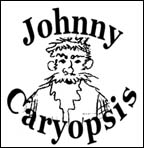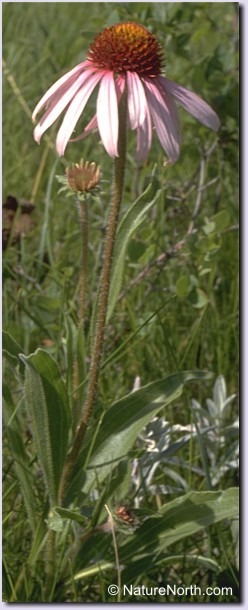 Our
Purple Coneflower - Little Echinacea on the Prairie. Our
Purple Coneflower - Little Echinacea on the Prairie.
By Johnny Caryopsis.
Mention the word “Echinacea” and
most people will have heard it and know its association with herbal
medicine. Echinacea in various forms is thought to be an immuno-stimulant
helping people to ward off diseases of various sorts, especially colds
and flus. But ask most people what Echinacea really is and where it
comes from and you’ll probably get nothing more than blank stares.
“Echinacea comes in a bottle”, is what you might hear.
Yeah, and meat comes from the store in a plastic wrap on a styrofoam
tray.
 I
recently read a report from Statistics Canada stating that, whereas
in the 1930’s and 40’s one in three Canadians lived on
a farm, now only one in 46 of us lives on a farm. The more our society
“advances”, the further we get from the land and nature
and knowing where stuff comes from. Echinacea comes from a plant,
or rather it is a plant. Echinacea is the genus name for a group of
North American wildflowers, called coneflowers, in the composite or
Asteraceae family. They all have large, showy daisy-like flowers and
they all contain chemical compounds thought to have medicinal value
for people. In fact, coneflowers are so full of cool chemicals they
are often said to be “pharmacological cornucopia” - try
saying that fast three times! I
recently read a report from Statistics Canada stating that, whereas
in the 1930’s and 40’s one in three Canadians lived on
a farm, now only one in 46 of us lives on a farm. The more our society
“advances”, the further we get from the land and nature
and knowing where stuff comes from. Echinacea comes from a plant,
or rather it is a plant. Echinacea is the genus name for a group of
North American wildflowers, called coneflowers, in the composite or
Asteraceae family. They all have large, showy daisy-like flowers and
they all contain chemical compounds thought to have medicinal value
for people. In fact, coneflowers are so full of cool chemicals they
are often said to be “pharmacological cornucopia” - try
saying that fast three times!
Manitoba's Purple Coneflower
in the wild: Click
for pic.
Manitoba’s mixed grass prairies in the
southwest of our province are home to one member of the coneflower
family, Narrow-leaved Purple Coneflower (Echinacea angustifolia).
I first came across these large, but straggly looking wildflowers
in the Souris River Valley Wildlife Management Area, south of Brandon.
As a wildflower they are not unattractive, but somehow, to me at least,
they look a little rough and out of place; not exactly a delicate
and graceful plant. And yet, Manitoba’s purple coneflower, though
not ranked highest for beauty, is rated the best of all the coneflowers
for its medicinal value. Another example of the hidden qualities of
those that dwell on the northern prairies, we humans included.
Our purple coneflower is an important indicator
species of good quality mixed grass prairie in this province. Sadly,
both the coneflower and our prairies are dwindling rapidly. Mixed
grass prairies are being plowed up to grow potatoes, overgrazed by
cattle, buried under concrete and ashphalt, and covered over by human
homes and lawns. Purple coneflowers, a plant we have only just begun
to appreciate and explore for useful compounds may soon disappear
from the wilds of Manitoba. We humans really are in danger of cutting
off our noses to spite our faces. The planet can’t keep giving
up species and wild places forever. We can only push the biosphere’s
house of cards so far before it comes tumbling down.
So I keep writing about nature in Manitoba
for NatureNorth, and hoping that I touch a few people with each article.
And they in turn tell others and ultimately enough people can start
caring enough about our natural heritage that we collectively act
to protect what’s left. Sometimes, though, it feels like I’m
writing an obituary of Manitoba’s natural heritage. I hope you’ll
prove me wrong.
For some more on Purple Coneflowers and Echinacea,
click the right arrow below.
EDITOR'S NOTE: This article contains some
public domain images gathered from Wikimedia Commons. Please
Click Here
for more info on our use of such images.
|
|

![]()
 Our
Purple Coneflower - Little Echinacea on the Prairie.
Our
Purple Coneflower - Little Echinacea on the Prairie. I
recently read a report from Statistics Canada stating that, whereas
in the 1930’s and 40’s one in three Canadians lived on
a farm, now only one in 46 of us lives on a farm. The more our society
“advances”, the further we get from the land and nature
and knowing where stuff comes from. Echinacea comes from a plant,
or rather it is a plant. Echinacea is the genus name for a group of
North American wildflowers, called coneflowers, in the composite or
Asteraceae family. They all have large, showy daisy-like flowers and
they all contain chemical compounds thought to have medicinal value
for people. In fact, coneflowers are so full of cool chemicals they
are often said to be “pharmacological cornucopia” - try
saying that fast three times!
I
recently read a report from Statistics Canada stating that, whereas
in the 1930’s and 40’s one in three Canadians lived on
a farm, now only one in 46 of us lives on a farm. The more our society
“advances”, the further we get from the land and nature
and knowing where stuff comes from. Echinacea comes from a plant,
or rather it is a plant. Echinacea is the genus name for a group of
North American wildflowers, called coneflowers, in the composite or
Asteraceae family. They all have large, showy daisy-like flowers and
they all contain chemical compounds thought to have medicinal value
for people. In fact, coneflowers are so full of cool chemicals they
are often said to be “pharmacological cornucopia” - try
saying that fast three times!